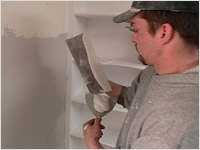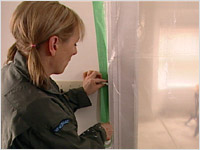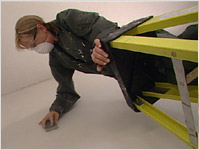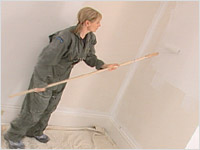| | | | |
| |


|
|
The uneven texture of Brigitte’s century-old plaster and lath walls is the perfect look for some rooms. But when those walls need to be smoothed out, playing Picasso with the plaster is not good enough. There’s a definite art to perfect plaster.
 |
 |
 |
 |
 |
 |
|
 |
DO use the right tools. The cheaper plastic models just don’t cut it.
|
 |
DON’T hesitate to let the experts help you out. They have just the right wrist action to get a perfect smooth finish.
|
|
 |
 |
 |
 |
Perfect Plaster
Tips for perfect plaster:
- Buy quality plaster that applies smoothly and holds up over time.
- Use a professional quality trowel that has a sharp edge and a proper handle. (see fig. A)
- Getting a smooth finish is much more difficult than it looks. If you need help ask a professional who can do the job with just the right touch.
- When the plaster dries, it needs to be sanded. Before you start, send the kids and the dogs to a friend’s house – unless you like dusty paw prints as part of your décor.
 |
|
 |
| Fig. A |
|
Fig. B |
- Seal the room off with a sheet of plastic to contain the dust to one area. (see fig. B)
- Wear a mask!
- Before you start, hold a trouble light up close to the wall. The shadows reveal any ridges and burrs that need to be smoothed out.
- Carefully sand down all of the newly plastered walls. (see fig. C)
 |
|
 |
| Fig. C |
|
Fig. D |
- When you’re finished, brush off any dust from the surface then vacuum, vacuum, and vacuum.
- Before you paint or wallpaper over the new wall, it must be sealed with primer. (see fig. D)
- You’ve earned it! Give yourself a facial to remove the dust and –this is important - treat yourself to the best moisturizer money can buy.
|
|